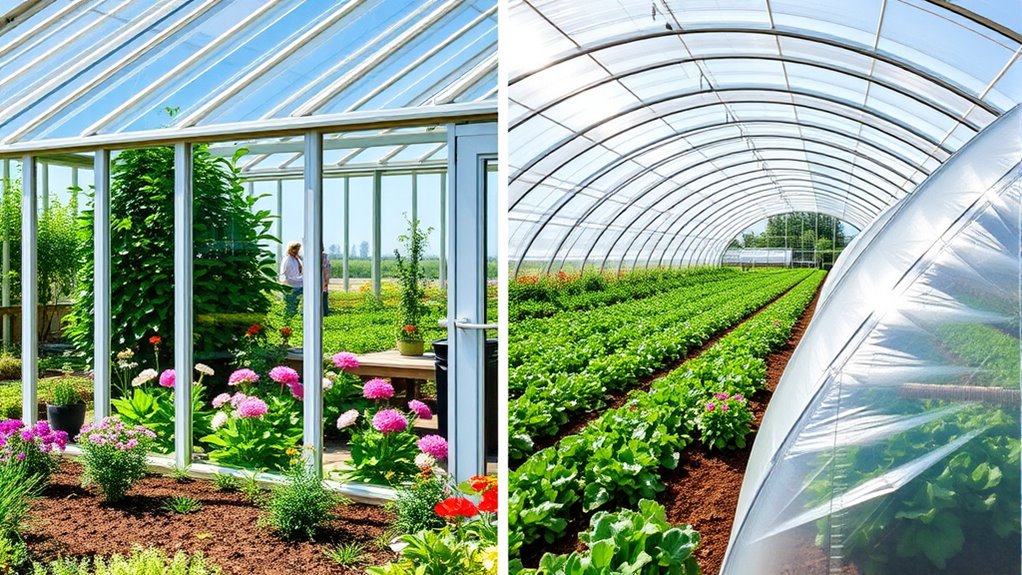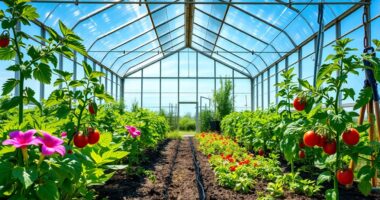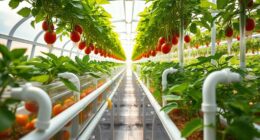When deciding between a greenhouse and a polytunnel, you’ll notice key differences. Greenhouses offer better insulation, higher light transmission, and more robust temperature control, making them ideal for delicate plants. However, they’re more expensive and require careful construction. Polytunnels, on the other hand, are affordable, quick to install, and adaptable, perfect for hardy crops and changing weather. Each option has its pros and cons, and choosing the right one depends on your gardening needs and preferences. Discover more insights below!
Key Takeaways
- Greenhouses feature aluminum frames and glass/polycarbonate panels, providing superior insulation compared to polytunnels, which use polythene over metal hoops.
- Polytunnels are significantly cheaper to install, costing about one-third of a greenhouse, making them ideal for budget-conscious gardeners.
- Greenhouses excel in temperature regulation, retaining heat and allowing for integrated heating systems, while polytunnels heat up quickly but lose warmth rapidly.
- Greenhouses provide optimal light transmission and humidity control, making them suitable for delicate crops, whereas polytunnels are better for hardier plants and adaptable setups.
- While polytunnel covers degrade over time and require maintenance, greenhouses offer a longer lifespan but demand more upkeep and higher initial investment.
Structural Differences
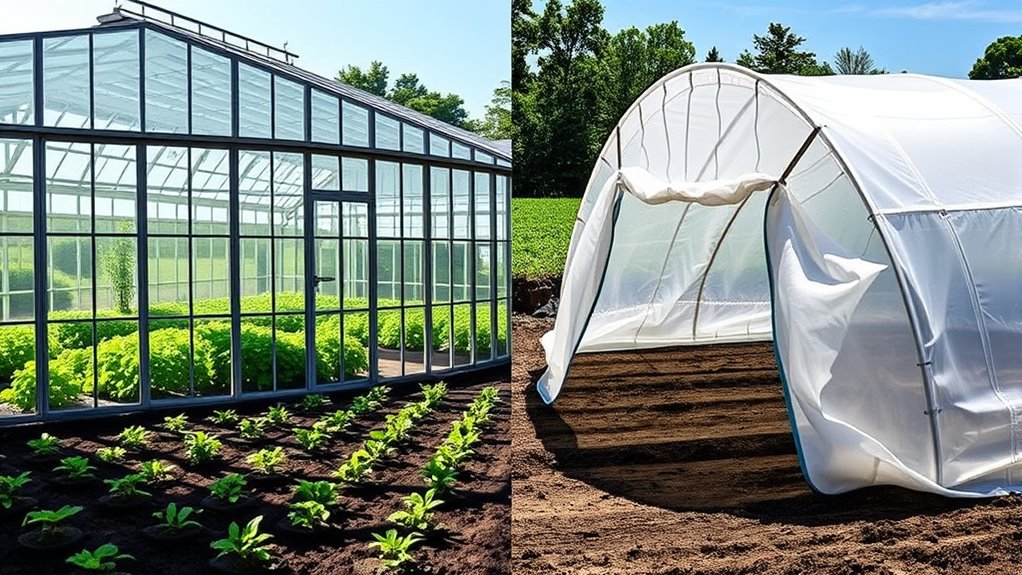
When considering greenhouse and polytunnel structures, you’ll notice distinct differences in their materials and designs.
Greenhouses typically feature durable aluminum frames and glass or polycarbonate panels, offering both longevity and aesthetic appeal. In contrast, polytunnels use a simpler design with polythene stretched over metal hoops, making them more affordable but requiring frequent cover replacements.
Greenhouses offer durability and aesthetic appeal, while polytunnels provide affordability with simpler designs and frequent cover replacements.
The installation process also varies; polytunnels can be erected quickly and on slightly uneven surfaces, while greenhouses need a perfectly level base and take more time to construct.
Additionally, greenhouses provide better insulation for delicate plants, whereas polytunnels allow for easy modifications and expansions, giving you flexibility in your gardening endeavors.
Each structure has its advantages based on your specific gardening needs.
Cost Considerations
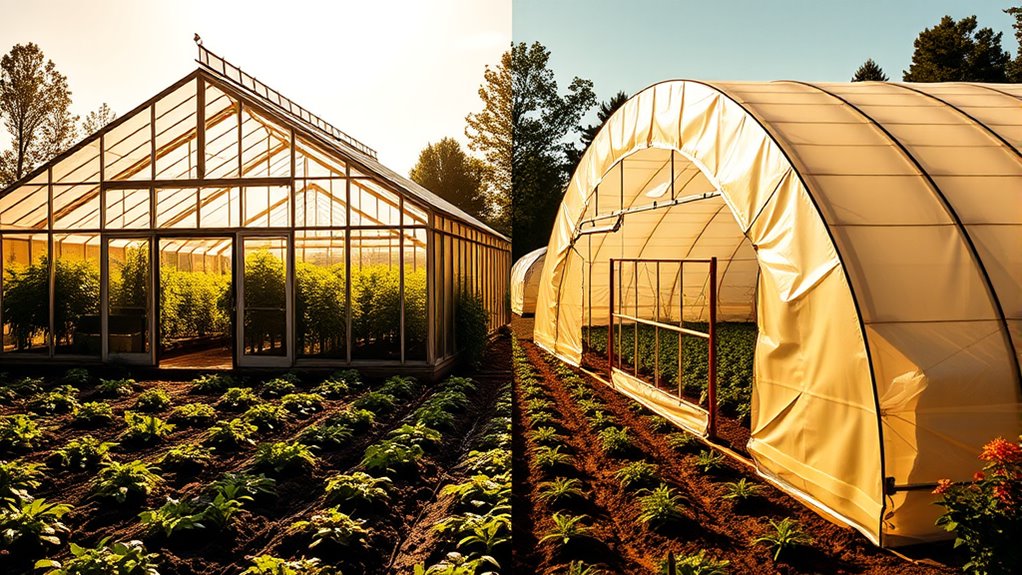
Understanding the cost considerations between greenhouses and polytunnels can significantly influence your gardening choices.
If you’re on a tight budget, polytunnels are a clear winner, often costing about a third of what you’d pay for a greenhouse. They provide more growing space for less money, especially in larger areas. Installation is typically quicker and cheaper, requiring less site preparation.
While polytunnel covers need replacement every 5-10 years, this expense is generally lower than replacing greenhouse glass. If you value aesthetics, a greenhouse might appeal more, but remember, the initial investment is higher.
In the long run, polytunnels offer better value for commercial or large-scale gardening due to lower costs and greater flexibility.
Environmental Control
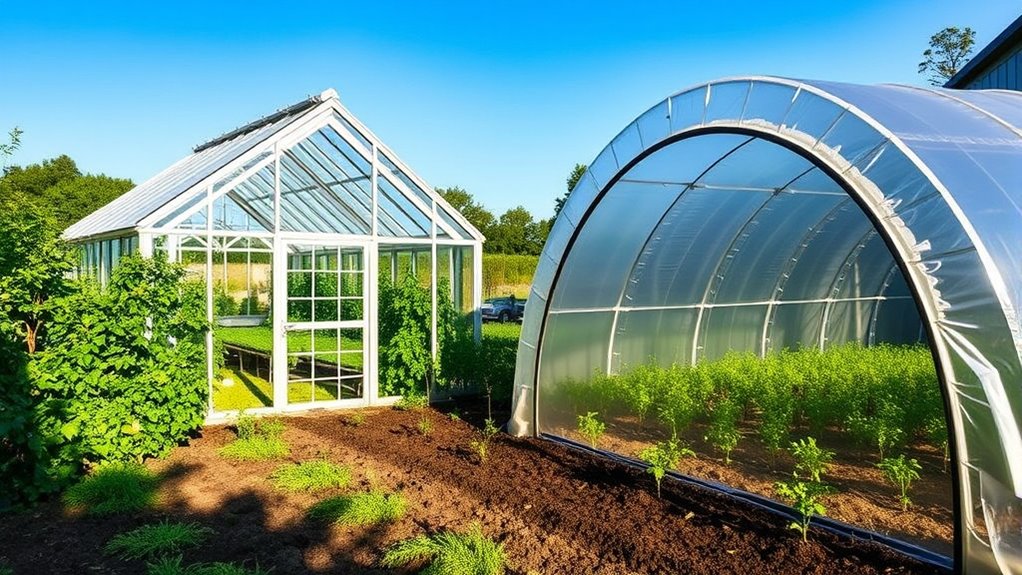
While both greenhouses and polytunnels serve the purpose of extending the growing season, their approaches to environmental control differ significantly.
Greenhouses excel at temperature regulation, retaining heat and maintaining stable conditions, especially in colder climates. They can integrate heating and cooling systems, ensuring optimal environments for your plants.
On the other hand, polytunnels heat up quickly but lose that warmth just as fast, making them less reliable for consistent growth.
When it comes to humidity, greenhouses offer advanced ventilation to manage moisture levels, while polytunnels rely on natural airflow, which can be inconsistent.
In terms of light management, greenhouses maximize light transmission and can include shading options, giving you more control over your plants’ growth conditions.
Growing Conditions

Growing conditions play a crucial role in the success of your plants, and choosing between a greenhouse and a polytunnel can significantly impact those conditions.
Choosing the right growing structure, whether a greenhouse or polytunnel, is vital for your plants’ success.
A greenhouse excels in temperature regulation, making it perfect for delicate or heat-loving plants, especially in colder climates. Its high light transmission supports plants that thrive in direct sunlight.
In contrast, polytunnels are more adaptable to sudden weather changes and are ideal for hardier, seasonal crops.
While both can manage humidity and provide ventilation, greenhouses offer advanced systems for better control.
If you want consistent year-round production and higher crop quality, a greenhouse is your best bet, while polytunnels provide excellent space efficiency and cost-effectiveness for larger-scale gardening.
Practicality and Flexibility
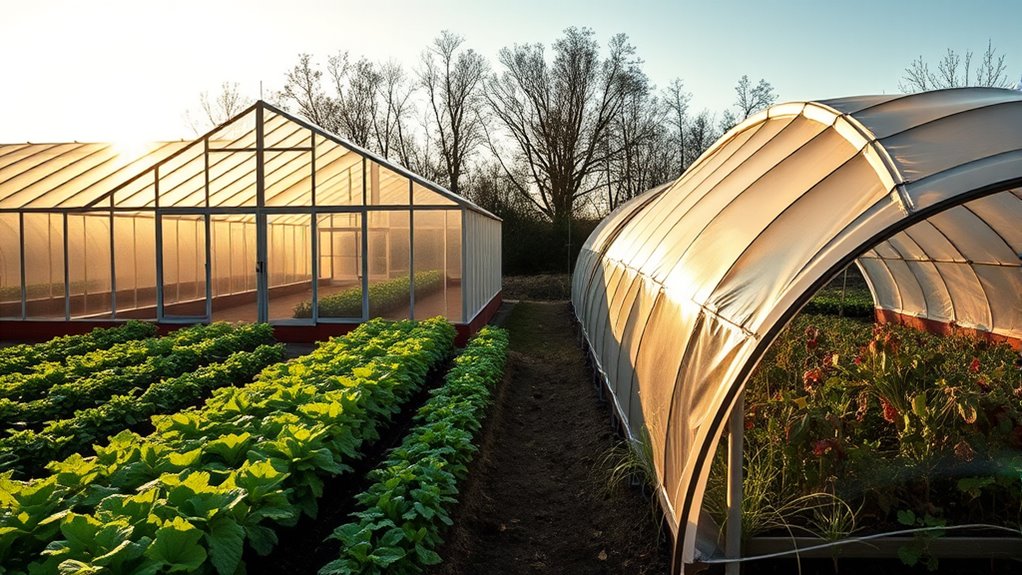
When it comes to practicality and flexibility, the choice between a greenhouse and a polytunnel becomes clearer.
Polytunnels are typically more affordable, especially for larger spaces, giving you better value for your investment. They’re quicker to set up and can be placed on uneven ground, unlike greenhouses that require a level base.
If you’re considering modifications or expansions, polytunnels offer easier solutions by adding more hoops and coverings. Plus, they’re more portable, allowing you to dismantle and move them with ease.
While greenhouses may have a longer lifespan with less maintenance, polytunnels provide the adaptability you might need for changing gardening conditions or personal preferences.
Applications and Suitability
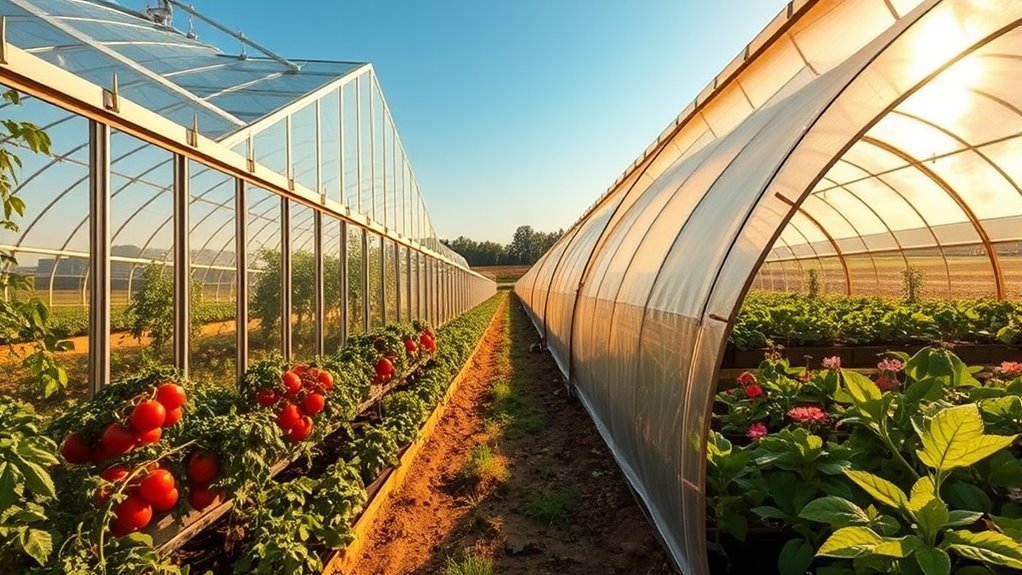
Choosing between a greenhouse and a polytunnel largely depends on your specific gardening needs and the climate you live in.
Deciding between a greenhouse and a polytunnel hinges on your gardening needs and local climate.
If you’re in a colder area, a greenhouse is ideal due to its heat retention, while polytunnels thrive in milder conditions. Both structures can extend your growing season.
For delicate plants needing precise temperature control, greenhouses excel; however, hardier plants flourish in the adaptable environment of polytunnels.
Greenhouses require a flat surface for installation and usually offer a compact design, whereas polytunnels can work on uneven ground and provide more growing space.
Budget-wise, greenhouses are pricier but durable, while polytunnels are cost-effective, although they require occasional plastic replacement. Additionally, understanding your energy consumption patterns can help optimize the conditions within either structure.
Consider your space, plant types, and budget to make the best choice.
Pros and Cons of Greenhouses
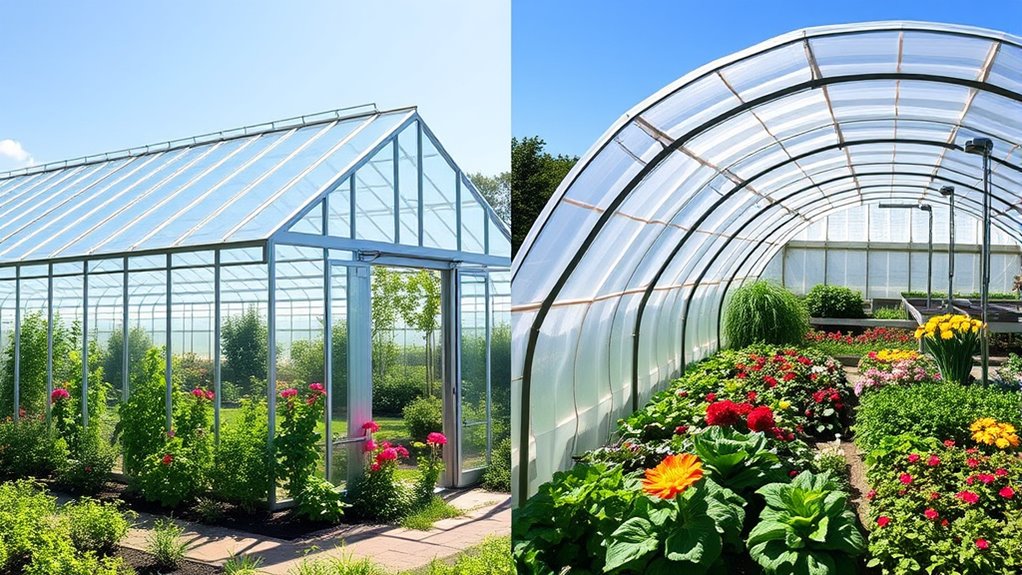
While greenhouses offer numerous benefits for gardeners, they also come with their share of drawbacks. You can enjoy year-round crop production and higher yields thanks to controlled environments, but setting up a greenhouse requires a significant initial investment.
Plus, maintaining optimal conditions can lead to high energy consumption. You’ll also need specialized knowledge to operate it effectively, as dependence on technology makes you vulnerable to potential failures. Regular maintenance can be labor-intensive and costly.
However, the reduced carbon footprint, water efficiency, and lower pesticide use highlight their environmental advantages. Additionally, using customization options for environmental controls can enhance the efficiency of your greenhouse. Ultimately, weighing these pros and cons helps you decide if a greenhouse is the right choice for your gardening needs.
Pros and Cons of Polytunnels

Polytunnels offer a range of advantages for gardeners looking to maximize their growing potential without breaking the bank.
They’re cost-effective, allowing you to expand your garden without a hefty price tag. Their flexibility means you can easily modify or enlarge them to fit your space. Plus, constructing a polytunnel is quick and doesn’t require a perfectly level base. Additionally, backyard greenhouses can be an excellent alternative for those seeking a more permanent structure. Moreover, the average time to build a tiny house ranges from 3 to 6 months, which may inspire those looking to create their own gardening spaces. Regular hydration techniques can also enhance plant health when using polytunnels, ensuring optimal growth conditions. Furthermore, the use of sustainable gardening practices can further enhance the effectiveness of polytunnels in promoting healthy plant growth.
However, they do have drawbacks. Polytunnel covers degrade over time, needing replacement every few years. They’re also vulnerable to strong winds if not secured properly.
Polytunnels have their downsides, including cover degradation and vulnerability to strong winds if not properly secured.
Additionally, while they provide good airflow, managing ventilation is crucial to prevent overheating. Lastly, polytunnels may have lower light transmission rates compared to greenhouses, impacting certain crops. Regular maintenance can enhance energy efficiency and prolong the lifespan of the structure.
Choosing the Right Option for Your Needs
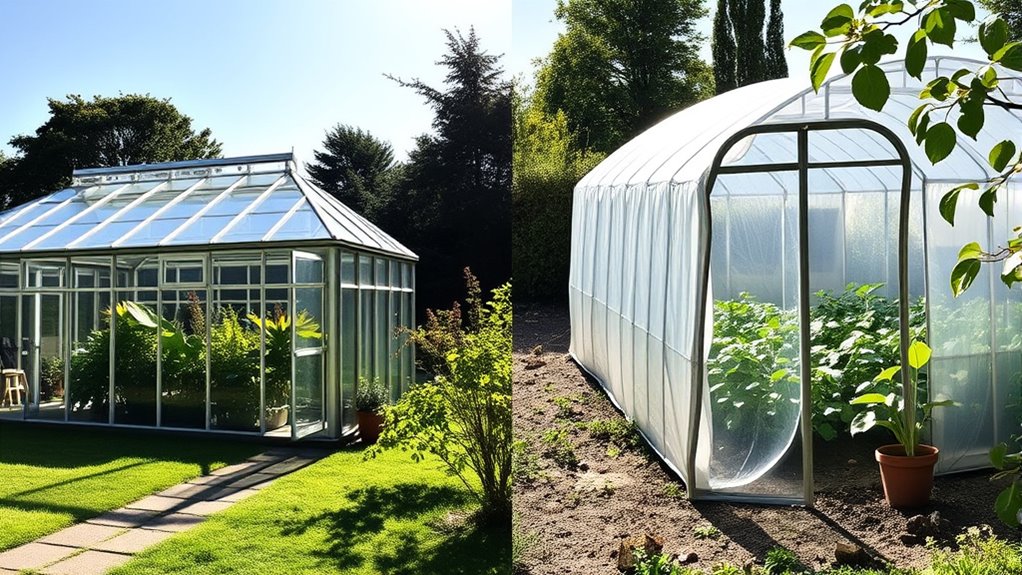
How do you decide between a greenhouse and a polytunnel for your gardening needs?
Start by considering your budget. If you’re looking for a cost-effective option, a polytunnel is generally cheaper and easier to set up.
However, if you want durability and aesthetic appeal, a greenhouse might be worth the higher initial investment.
Think about your local climate as well; greenhouses excel in colder areas, while polytunnels thrive in milder conditions.
Additionally, if you need flexibility, polytunnels can be modified and relocated more easily.
Finally, assess what you plan to grow—delicate plants do better in greenhouses, while hardier varieties flourish in polytunnels.
Choose the option that best matches your gardening goals and environment.
Case Studies: Successful Uses of Each Structure
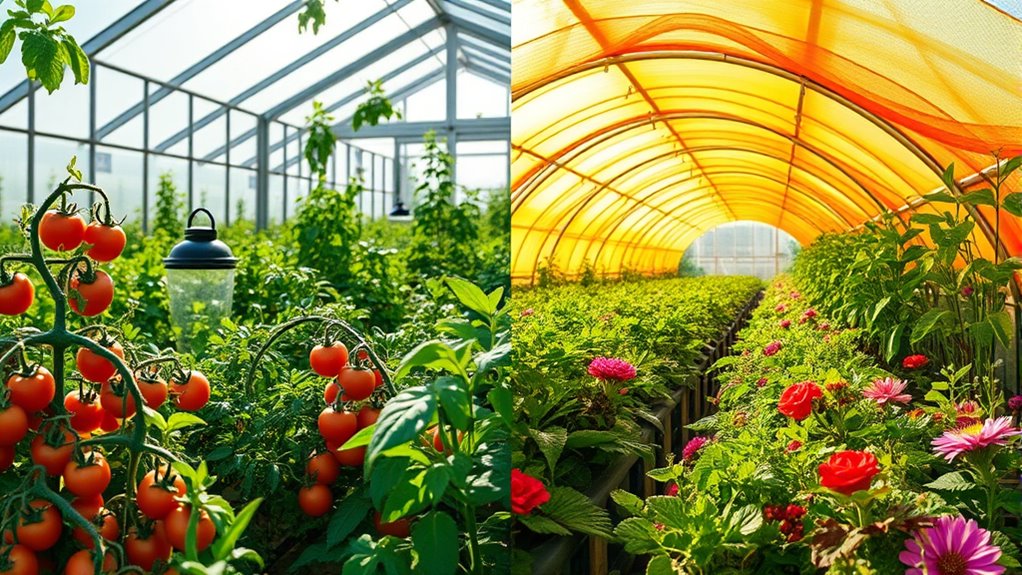
Numerous successful case studies highlight the benefits of both greenhouses and polytunnels in diverse gardening scenarios.
For instance, Cate Farm in Vermont uses biodiesel from waste vegetable oil to heat their greenhouse, showcasing energy efficiency. Sam Mazza’s Farmstand employs hard coal for heating, while Blais Farm utilizes an outdoor wood boiler.
On the polytunnel side, these structures are popular among amateur gardeners for growing tomatoes and strawberries due to their affordability and ease of setup. They effectively extend the growing season and protect crops from light frost.
High tunnels also offer better environmental control for larger operations. Both options provide unique advantages tailored to your gardening needs. Additionally, camping locations can influence the type of gardening structure you choose based on climate and environmental factors.
Frequently Asked Questions
How Do I Maintain My Greenhouse or Polytunnel?
To maintain your greenhouse or polytunnel, start by cleaning both the interior and exterior regularly to prevent diseases.
Ensure good ventilation by installing vents or fans, adjusting as needed for temperature control.
Inspect for pests frequently and manage them promptly.
Remove debris, check equipment, and monitor humidity levels.
In spring, deep clean, and prepare for winter by insulating.
Finally, keep the area weed-free to deter pests from entering.
What Crops Grow Best in Greenhouses Versus Polytunnels?
When you think of crop superstars, greenhouses are like the VIP lounges of the gardening world!
They’re perfect for sensitive crops like tomatoes, cucumbers, and citrus, thriving in their controlled paradise.
On the flip side, polytunnels are the casual hangouts, great for hardy plants like strawberries and peppers.
They adapt to the weather and keep your harvest rolling, but they may not boast the same luxurious conditions as their greenhouse counterparts!
Can I Use Both Structures Together in My Garden?
Yes, you can definitely use both structures together in your garden!
Combining a greenhouse and a polytunnel allows you to optimize growing conditions for a variety of plants. You’ll benefit from the temperature control of the greenhouse for sensitive crops, while the polytunnel provides better light diffusion and is easier to adjust.
Just consider your space and budget, and you’ll create a diverse and productive growing environment tailored to your needs.
How Long Does It Take to Set up Each Structure?
Setting up a greenhouse can take several days to a week due to its complexity and need for precise installation.
In contrast, a polytunnel typically requires just a few hours to a couple of days, thanks to its simpler design and lightweight materials.
While you might enjoy the durability of a greenhouse, you’ll appreciate the quick assembly of a polytunnel if time is of the essence.
Choose based on your priorities!
What Are the Insurance Considerations for Greenhouses and Polytunnels?
When considering insurance for your greenhouse or polytunnel, you’ll want to focus on coverage for structural damage, theft, and equipment.
Be aware of the risks from weather, fire, and vandalism. Crop insurance is essential for protecting your plants’ value.
Also, factor in your location and structure size, as these can impact premiums.
Regular maintenance not only keeps your setup safe but can also lower your insurance costs significantly.
Conclusion
In the battle of greenhouse vs. polytunnel, your choice boils down to your specific needs and budget. Each structure has its unique strengths and weaknesses, like two sides of the same coin. Whether you’re looking for enhanced environmental control or flexibility, both can help you cultivate a thriving garden. Take the time to assess your goals and resources, and you’ll find the perfect fit that’ll help your plants flourish and your gardening dreams bloom.
